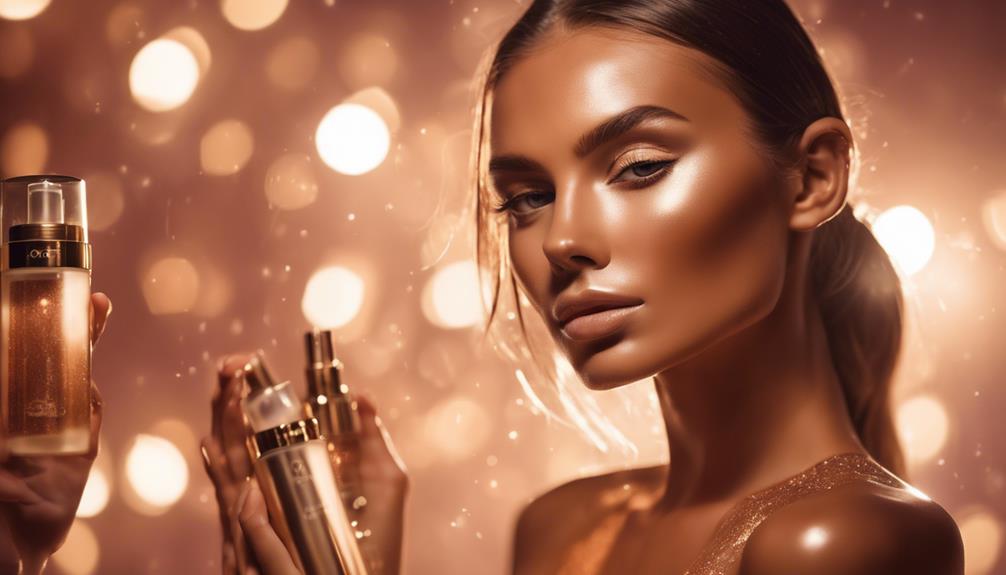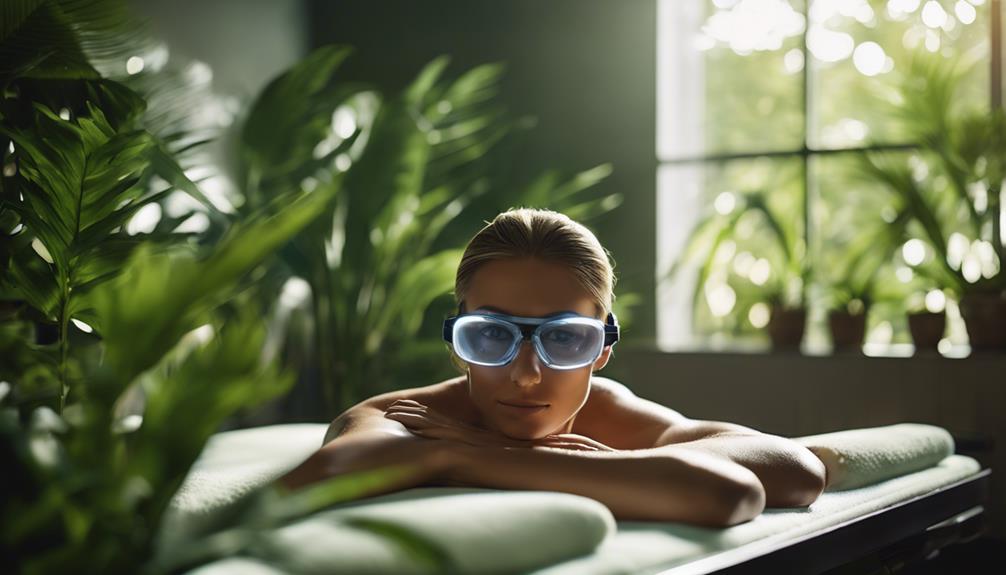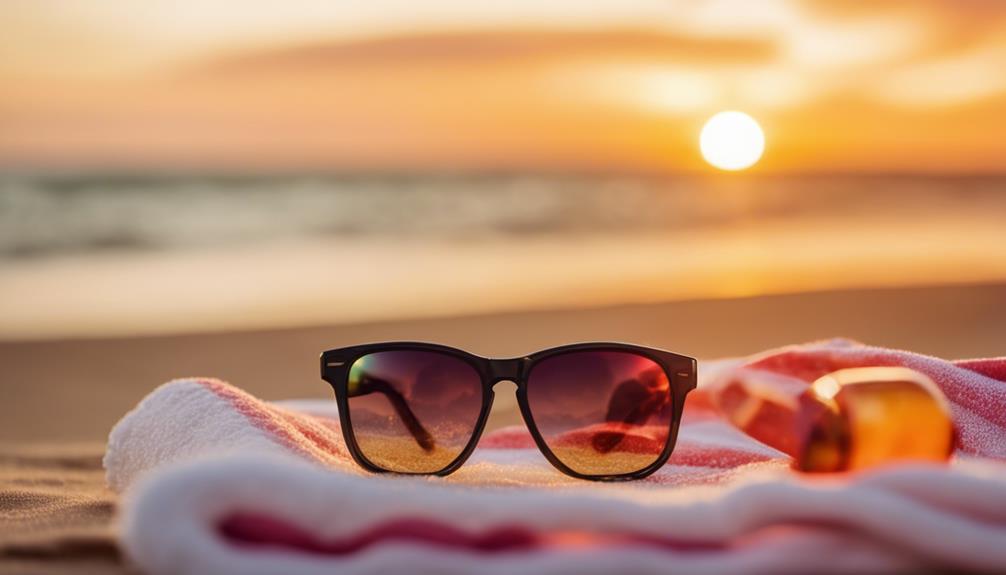To find the perfect tanning times for your skin type, it's all about knowing your own unique glow! If you've got fair skin (Type 1), stick to just 1-3 minutes—burn is no joke! For light beige to light brown (Type 2), aim for 2-4 minutes. If you're medium (Type 3), go for 4-8 minutes. Olive skin (Type 4)? You can stretch it to 4-9 minutes. For those with dark brown skin (Type 5), 4-10 minutes will do the trick. Always remember to protect your eyes and skin while tanning. There's more to discover about achieving that sun-kissed look, so hang tight! Timing tanning for wedding season is crucial for many individuals looking to achieve a natural glow for their special day. If you’re planning for a wedding and have fair skin, it’s best to start tanning at least a month in advance at shorter intervals, slowly increasing the time as the wedding date approaches. For those with darker skin, tanning can be started closer to the event, ensuring the perfect sun-kissed look for the big day. Remember to always consult with a professional to ensure the safest and most effective tanning schedule.
Key Takeaways
- Fair skin (Type 1) should tan for 1-3 minutes to avoid burns and skin damage.
- Light beige to light brown skin (Type 2) can safely tan for 2-4 minutes.
- Medium skin (Type 3) has a recommended tanning duration of 4-8 minutes for optimal results.
- Olive skin (Type 4) can tolerate tanning sessions lasting 4-9 minutes without significant burn risk.
Skin Type Overview
Understanding your skin type is essential for achieving the perfect tan while minimizing the risk of burns and damage.
So, what's your skin type?
If you have fair skin (Type 1), you're likely to burn easily, so be super careful!
Type 2 means you've got light beige to light brown skin—you're a bit more resistant but still need to watch out.
Moving on to Type 3, you've got medium skin, which means tanning is easier for you.
Type 4, with olive skin, is even less prone to burns.
Finally, if you're Type 5, with dark brown skin, you're pretty resilient, but that doesn't mean you can forget sunscreen.
Tanning Duration Guidelines

To achieve the perfect tan, it's crucial to know the recommended tanning durations for your specific skin type. Each skin type has its own guidelines, so don't just wing it! Here's a quick reference to help you out:
| Skin Type | Recommended Duration |
|---|---|
| Type 1 | 1-3 minutes |
| Type 2 | 2-4 minutes |
| Type 3 | 4-8 minutes |
| Type 4 | 4-9 minutes |
| Type 5 | 4-10 minutes |
Starting with shorter sessions helps your skin get used to the UV rays. Think of it as dipping your toes in a pool before jumping in! Gradually increase your time based on how your skin reacts. Happy tanning!
Safety Measures for Tanning

Protecting your skin during tanning is essential to avoid burns and long-term damage.
First things first, always wear protective eyewear—those UV rays can be sneaky!
Next, slather on a good tanning lotion to keep your skin hydrated and happy. It's like giving your skin a big hug!
Pay close attention to how your skin reacts; if it starts to feel hot or looks red, it's time to cut back.
Gradually increasing your tanning sessions is key—think of it as giving your skin a chance to build up its tan without panicking.
And remember, while a golden glow is great, safety should always shine brighter!
Tanning Bed Schedule

A well-structured tanning bed schedule helps you achieve that sun-kissed glow while minimizing the risk of burns.
Start with shorter sessions, around 5-10 minutes, to let your skin get used to the UV rays. If you're fair-skinned, you might need to be extra careful and start even shorter.
As your skin adapts, gradually increase your time—just don't go from zero to hero overnight! Aim for about 2-3 sessions a week, giving your skin a day or two to recover in between.
And remember, applying a good tanning lotion can really amp up your results.
Alternative Tanning Methods

While tanning beds offer convenience and controlled exposure, exploring alternative tanning methods can provide a safe and effective way to achieve that desired sun-kissed look.
Have you ever tried self-tanners? They come in lotions, sprays, or even mousses, giving you a gorgeous glow without the sun's harmful rays. Plus, they're super easy to use! Just apply, wait for a bit, and voilà!
For those who love a little color but want to avoid the orange hue, consider tinted moisturizers. They hydrate your skin while adding a hint of bronze.
Finally, don't forget about bronzers! These magical powders can instantly give you a sun-kissed effect.
Preparing for Tanning Sessions

Before hitting the tanning bed, guarantee your skin's ready with proper preparation to maximize results and minimize risks.
First, cleanse your skin to remove any lotions or oils, allowing the tanning bed's rays to work their magic.
Next, grab those protective goggles—you wouldn't want to end up with raccoon eyes, right?
Applying a good tanning lotion is essential; it hydrates your skin and helps you achieve that golden glow.
Make sure to check your skin for any cuts or irritations, as they might throw a wrench in your tanning plans.
Finally, remember to stay relaxed and enjoy the process. You're not just getting a tan; you're indulging in some well-deserved self-care!
Happy tanning!
Tanning Bed Maintenance Tips

Proper maintenance of tanning beds guarantees not only their longevity but also your safety and the effectiveness of your tanning sessions.
First, always clean the bed after each use; a quick wipe down with disinfectant keeps things fresh and free of germs, plus it makes the bed look shiny!
Don't forget to check the bulbs regularly; if they're dim, it's time for a change.
Also, make certain you have proper eye protection ready—no one wants to end up with raccoon eyes!
Finally, make sure the bed is well-ventilated; nobody enjoys feeling like they're in a sauna while tanning.
Frequently Asked Questions
How Often Should I Use a Tanning Bed for Best Results?
You should use a tanning bed 2-3 times a week initially, gradually increasing frequency based on your skin's response. Always listen to your skin and allow adequate recovery time between sessions for best results.
Can I Use Tanning Beds in Winter Months?
If you're feeling pale in winter, using tanning beds can boost your glow. Just remember to start slow and listen to your skin; it'll let you know when it's had enough. Enjoy the warmth!
What Are the Signs of Overexposure to Tanning?
If you've overexposed your skin to tanning, you might notice redness, peeling, or a burning sensation. Watch for blisters or dark spots too. It's vital to give your skin time to heal and recover.
Do Tanning Beds Cause Skin Aging or Damage?
Imagine a garden thriving under the sun; overexposure can wilting flowers. Tanning beds accelerate skin aging and damage, making you more prone to wrinkles and sunspots. Moderation and protection are key to preserving your skin's health.
Are There Specific Lotions Recommended for Different Skin Types?
When choosing lotions, consider your skin type. For fair skin, opt for moisturizing products with SPF, while darker skin benefits from hydrating formulas. Always test new lotions to guarantee they suit your skin's unique needs.
Conclusion
Now that you're armed with all this tanning knowledge, remember: 'A little sun can go a long way!'
Whether you've got fair, olive, or dark brown skin, it's all about finding that sweet spot for your tanning sessions.
Stay safe, listen to your skin, and don't forget your sunscreen!
With the right approach, you'll be rocking that gorgeous glow in no time.
So, grab your shades and enjoy the sunshine—responsibly!









